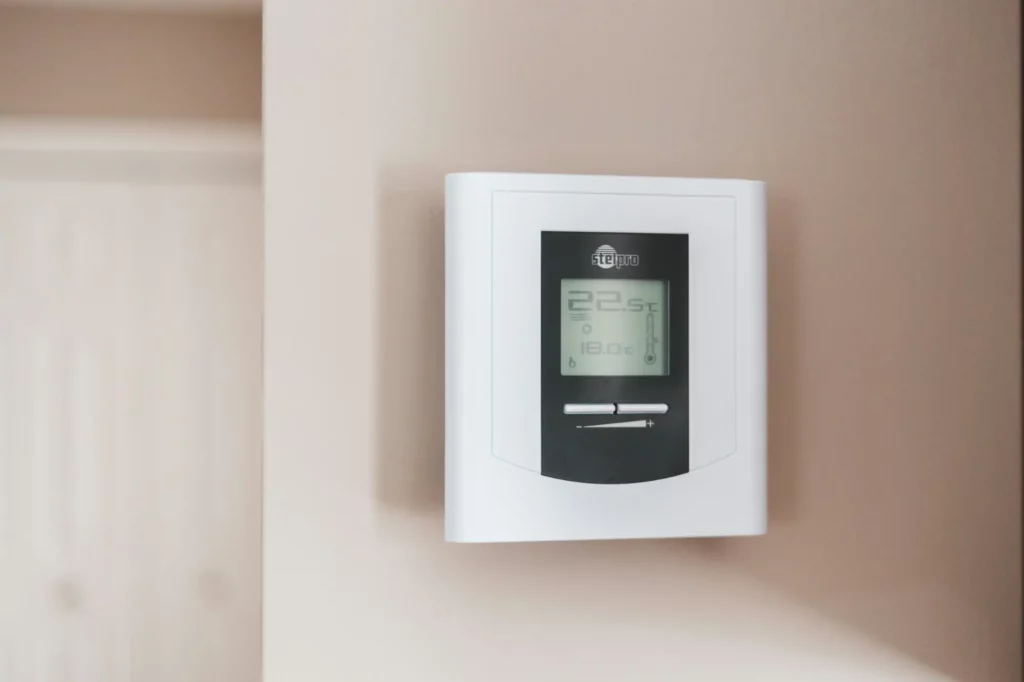
Your air conditioning is designed to beat the heat, but if your monthly energy bill is still leaving you sweating, then it’s time to start thinking about conserving energy this summer. Cutting back on your electricity usage is all about finding ways to improve the efficiency of your air conditioning, and one of the best ways to do this is with an energy-saving thermostat.
Your thermostat is the “brain” of your HVAC system, helping it to achieve your desired temperatures. However, most thermostats are essentially blunt instruments that don’t operate very efficiently. As a result, a great deal of energy can be wasted. That’s why investing in a smart thermostat is one of the best choices you can make for improving the overall energy efficiency in your home.
In the following article, we’ll explain what smart thermostats are, how they work, and some of the many benefits they offer when it comes to summer energy savings.

As the control system of your HVAC unit, your thermostat signals your AC unit to switch on and off as needed until your preferred temperature is achieved. Traditional thermostats can only be operated by manual controls, and the temperature is only adjusted when you make the conscious decision to change the setting.
“Smart” thermostats, on the other hand, are so named because they use an internal computer to determine what the optimal settings are and make adjustments accordingly. This allows the system to operate far more precisely.
These thermostats also make use of advanced technology in their interface, including the Infinity® System, which allows the user to track temperature, humidity, ventilation, and airflow. Thermostats with this technology are sold and installed by HVAC companies such as All Weather Heating & Cooling.
One of the key benefits smart thermostats have over traditional ones is their ability to be controlled remotely. Their Wi-Fi connection allows you to adjust the settings from anywhere, simply by using your smartphone or internet-capable device. This can both improve the comfort of your home and help you save on energy costs.
For example, if you forget to turn the thermostat up or down before you leave home, you can easily do so from elsewhere, allowing you to avoid wasting energy cooling a building that isn’t occupied. In turn, you can activate the air conditioning shortly before you arrive so the house will be nice and cool by the time you get there. Without a smart thermostat, the only way to maintain this level of comfort is to leave the system running the whole time you are away: a highly inefficient (and expensive) way of staying cool during the summer.
Every home is different and has different cooling needs. For that matter, each person also has their own specific needs and preferences when it comes to cooling. Over time, a smart, energy-saving thermostat can learn your habits and the specific quirks of your home and implement them automatically.
For example, many people prefer their home to be a little cooler at night than it is during the day. If you go to bed at 10:00 p.m. and wake up at 6:00 a.m., then your thermostat can adapt to this preference. Shortly before bedtime, it will signal your AC unit to begin lowering the temperature. Just before you wake up, the temperature will begin to increase again. Slightly raising the temperature won’t just make you more comfortable: it will also reduce the system’s overall energy use and save you money on your electricity bill.
While your smart thermostat can certainly do a lot of the work when it comes to determining the optimal settings for your home, we don’t mean to imply that it will take the control out of your hands. Actually, the opposite is true: an energy-saving thermostat can give you more control than you’ve ever had by providing you with detailed information about your power usage.
These energy usage reports can be eye-opening. For example, you might start to see times of day when your HVAC system’s power use spikes. Sometimes, these can indicate a behavior you may want to change. For example, are the kids leaving the door open when they head out to play and allowing cooled air to escape your home?
Your energy usage report can also help you to discover flaws in your HVAC setup. For example, if you find that your energy use is increasing over time—despite the fact that the outside temperatures are consistent—then it might mean your insulation is starting to degrade or your filter or ductwork needs cleaning. Catching and solving these problems quickly can help prevent increased costs down the road.
Smart thermostats don’t just benefit homeowners, either. By reducing overall energy usage, they are a more green option that helps to reduce your overall carbon footprint. In a world that is increasingly concerned with cutting back on carbon emissions, making the move toward more efficient HVAC technology is the responsible choice.
Choosing a greener method of cooling your home can also provide you with other economic benefits. For instance, you may be able to take advantage of tax credits in your area, as well as other government incentive programs.
There are many different models of energy-saving thermostats to choose from. Selecting the right one for your home is a matter of selecting one that can best function with your HVAC system and interface effectively with your smartphone and other technology.
You will, of course, also want to opt for the most efficient model you can find. A good smart thermostat will likely have the government’s Energy Star label on it, indicating that it has been certified for energy savings. A list of products that match this requirement can be found on the Energy Star website. Speak with your HVAC company today to improve the comfort of your home and save money while doing so.
comments